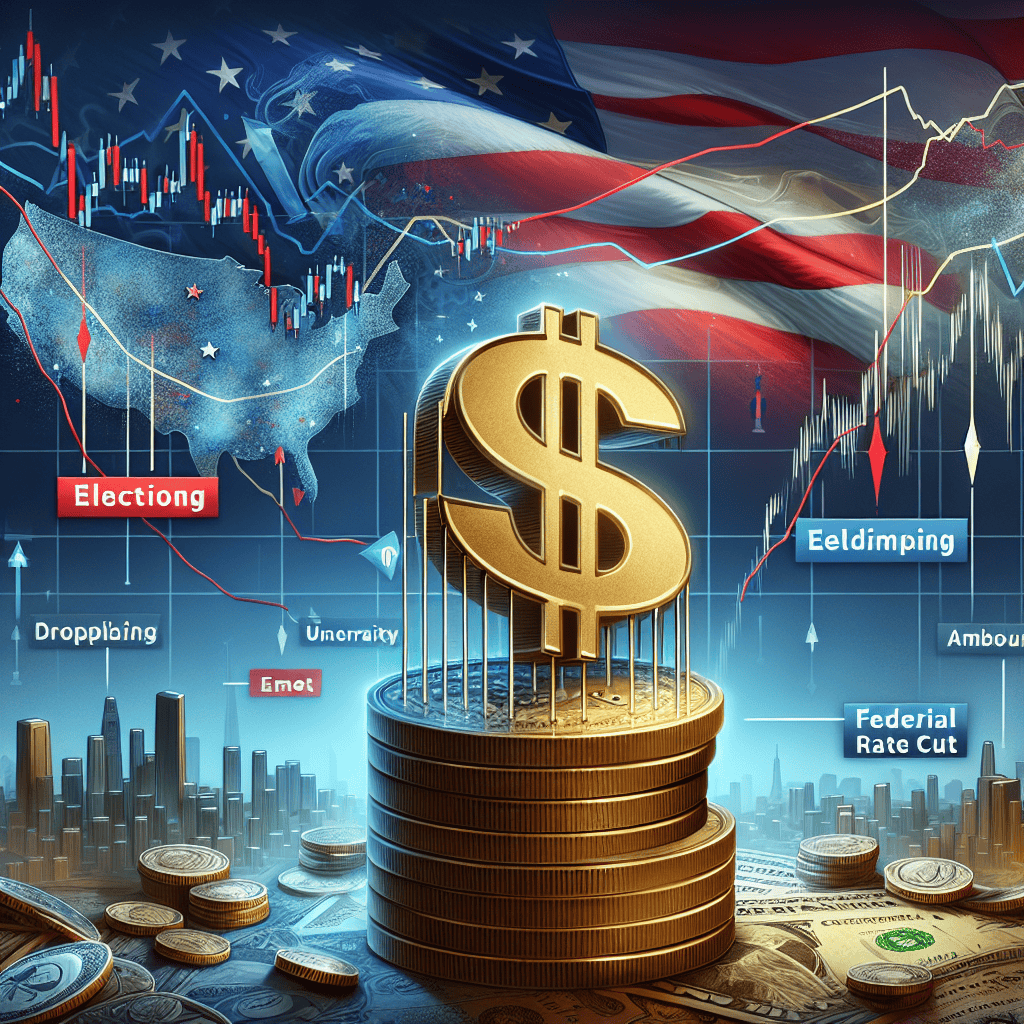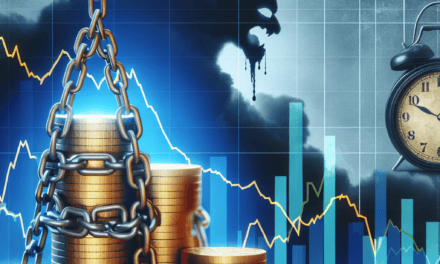“Unsteady Greenback: Election Jitters and Rate Cut Loom Over Dollar’s Future”
Introduction
The dollar has experienced a notable decline as uncertainty surrounding the US election intensifies and speculation mounts over an imminent rate cut by the Federal Reserve. Investors are grappling with the potential implications of a contested election outcome, which could lead to prolonged political instability and economic uncertainty. At the same time, the Federal Reserve’s anticipated move to lower interest rates aims to bolster economic growth but also contributes to the weakening of the dollar. This dual pressure from political and monetary fronts is creating a complex landscape for currency markets, prompting investors to reassess their strategies in light of these unfolding events.
Impact Of US Election Uncertainty On The Dollar’s Value
The value of the US dollar has long been a barometer of economic stability and investor confidence. However, recent developments have cast a shadow over its strength, primarily due to the uncertainty surrounding the upcoming US elections and the anticipated rate cut by the Federal Reserve. As the political landscape becomes increasingly unpredictable, investors are growing wary, leading to a decline in the dollar’s value. This situation is further compounded by the Federal Reserve’s signals of an imminent rate cut, which traditionally exerts downward pressure on the currency.
To begin with, the uncertainty surrounding the US elections has created a climate of apprehension among investors. Historically, election periods are fraught with volatility, as market participants attempt to gauge the potential economic policies of future administrations. This year, the stakes are particularly high, with significant policy differences between the candidates on issues such as taxation, trade, and regulation. Consequently, investors are adopting a cautious stance, preferring to hold off on major financial decisions until a clearer picture emerges. This hesitancy is reflected in the foreign exchange markets, where the dollar has experienced a noticeable decline.
Moreover, the Federal Reserve’s anticipated rate cut adds another layer of complexity to the dollar’s predicament. Interest rates are a critical factor in determining a currency’s value, as they influence the return on investments denominated in that currency. A lower interest rate typically makes a currency less attractive to investors seeking higher yields, thereby reducing demand and, consequently, its value. The Federal Reserve’s decision to cut rates is largely driven by the need to stimulate economic growth amid signs of a slowing economy. However, this move, while potentially beneficial for domestic economic activity, poses challenges for the dollar on the international stage.
In addition to these factors, global economic conditions also play a role in shaping the dollar’s trajectory. The interconnectedness of the global economy means that developments in other regions can have ripple effects on the US currency. For instance, economic slowdowns in major trading partners can lead to reduced demand for US exports, further dampening the dollar’s appeal. Additionally, geopolitical tensions and trade disputes can exacerbate market uncertainties, prompting investors to seek refuge in other currencies perceived as more stable.
Despite these challenges, it is important to recognize that the dollar remains a dominant force in the global financial system. Its status as the world’s primary reserve currency provides a degree of resilience, as central banks and financial institutions continue to hold substantial dollar reserves. Furthermore, the US economy, despite its current challenges, remains one of the largest and most dynamic in the world, offering a level of economic security that is attractive to investors.
In conclusion, the decline in the dollar’s value amid US election uncertainty and the prospect of a Federal Reserve rate cut underscores the complex interplay of political, economic, and global factors that influence currency markets. While the current environment presents challenges, it also highlights the importance of stability and confidence in maintaining the dollar’s strength. As the election approaches and the Federal Reserve’s policy decisions unfold, market participants will be closely monitoring these developments, seeking to navigate the uncertainties that lie ahead.
How Imminent Fed Rate Cuts Influence Currency Markets
The recent decline of the U.S. dollar has captured the attention of investors and economists alike, as it unfolds against a backdrop of political uncertainty and anticipated monetary policy adjustments. The interplay between these factors is complex, yet understanding how imminent Federal Reserve rate cuts influence currency markets is crucial for grasping the broader economic implications. As the U.S. approaches a pivotal election period, the political landscape is fraught with uncertainty, which invariably affects investor confidence. Historically, such periods of political ambiguity tend to lead to increased market volatility, as investors seek safe-haven assets to mitigate potential risks. Consequently, the dollar often experiences fluctuations, as its value is closely tied to investor sentiment and global economic stability.
Simultaneously, the Federal Reserve’s monetary policy decisions play a significant role in shaping currency markets. The anticipation of a rate cut by the Fed is a critical factor influencing the dollar’s recent decline. Lower interest rates generally lead to a decrease in the yield on dollar-denominated assets, making them less attractive to investors seeking higher returns. This diminished appeal can result in a reduced demand for the dollar, thereby exerting downward pressure on its value. Moreover, the prospect of a rate cut signals the Fed’s intention to stimulate economic activity by making borrowing cheaper, which can have mixed effects on the currency. While it may boost domestic economic growth, it can also lead to inflationary pressures, further complicating the currency’s trajectory.
In addition to these domestic factors, the global economic environment also plays a pivotal role in influencing currency markets. As other central banks around the world adjust their monetary policies in response to the Fed’s actions, the relative strength of the dollar is affected. For instance, if other major economies maintain higher interest rates, their currencies may become more attractive to investors, leading to a shift in capital flows away from the dollar. This dynamic underscores the interconnectedness of global financial markets and the importance of considering international developments when analyzing currency trends.
Furthermore, the interplay between fiscal and monetary policy cannot be overlooked. As the U.S. government implements fiscal measures to address economic challenges, these actions can either complement or counteract the Fed’s monetary policy objectives. For example, expansive fiscal policies, such as increased government spending, can stimulate economic growth and potentially offset some of the negative impacts of a weaker dollar. However, they can also exacerbate inflationary pressures, complicating the Fed’s efforts to maintain price stability.
In conclusion, the decline of the U.S. dollar amid election uncertainty and imminent Fed rate cuts is a multifaceted issue that reflects the intricate relationship between political developments, monetary policy, and global economic conditions. As investors navigate this complex landscape, understanding the factors influencing currency markets is essential for making informed decisions. The interplay between domestic and international forces highlights the need for a comprehensive approach to analyzing currency trends, as well as the importance of remaining vigilant in the face of evolving economic dynamics. As the situation continues to unfold, the actions of policymakers and their impact on investor sentiment will remain key determinants of the dollar’s trajectory in the coming months.
Historical Trends: Dollar Performance During Election Years
The performance of the U.S. dollar during election years has historically been a subject of keen interest for economists, investors, and policymakers alike. As the world’s primary reserve currency, the dollar’s fluctuations can have far-reaching implications for global markets. In the context of the current year, the dollar’s decline amid U.S. election uncertainty and the anticipation of an imminent Federal Reserve rate cut is a phenomenon that echoes past trends, yet also presents unique challenges and opportunities.
Historically, election years in the United States have often been characterized by heightened volatility in financial markets, with the dollar frequently experiencing fluctuations as investors react to the political landscape. This volatility is typically driven by the uncertainty surrounding potential changes in economic policy, which can influence investor confidence and, consequently, currency valuations. For instance, during the 2008 election year, the dollar experienced significant volatility as the global financial crisis unfolded, leading to a flight to safety that initially strengthened the dollar before subsequent policy measures and economic concerns led to its decline.
Similarly, in the 2016 election year, the dollar saw fluctuations as markets reacted to the unexpected outcome of the presidential election. The initial uncertainty was followed by a period of dollar strength, driven by expectations of fiscal stimulus and tax reforms. However, as policy implementation faced hurdles, the dollar’s performance became more subdued. These historical patterns underscore the complex interplay between political events and currency markets, where investor sentiment and policy expectations can lead to rapid shifts in the dollar’s value.
In the current year, the dollar’s decline is being influenced by a confluence of factors, with election uncertainty playing a significant role. As candidates present differing economic agendas, investors are closely monitoring potential shifts in trade policies, fiscal measures, and regulatory changes. This uncertainty is compounded by the Federal Reserve’s anticipated rate cut, which is expected to further impact the dollar’s performance. Historically, lower interest rates tend to weaken a currency as they reduce the returns on investments denominated in that currency, prompting investors to seek higher yields elsewhere.
Moreover, the global economic landscape adds another layer of complexity to the dollar’s performance during this election year. With ongoing geopolitical tensions and varying recovery trajectories from the pandemic, the dollar’s role as a safe-haven currency is being tested. In previous election years, global economic conditions have often amplified domestic political uncertainties, leading to more pronounced currency movements. For example, during the 2000 election year, the dot-com bubble burst and subsequent economic slowdown contributed to a weaker dollar, as investors reassessed risk and growth prospects.
In conclusion, while the dollar’s decline amid U.S. election uncertainty and an imminent Fed rate cut is consistent with historical trends, the current environment presents unique challenges. The interplay between domestic political developments, monetary policy decisions, and global economic conditions will continue to shape the dollar’s trajectory. As history has shown, election years are often marked by significant currency volatility, and this year is proving to be no exception. Investors and policymakers alike must navigate this complex landscape, balancing short-term market reactions with long-term economic objectives.
Investor Strategies Amid Dollar Decline And Economic Uncertainty

As the dollar experiences a decline amid the uncertainty surrounding the upcoming U.S. elections and the anticipated Federal Reserve rate cut, investors are faced with the challenge of navigating a complex economic landscape. The interplay between political developments and monetary policy decisions has created a volatile environment, prompting investors to reassess their strategies. In this context, understanding the underlying factors contributing to the dollar’s depreciation and exploring potential investment avenues becomes crucial.
The uncertainty surrounding the U.S. elections has been a significant driver of the dollar’s recent decline. Political instability often leads to market volatility, as investors grapple with the potential implications of policy changes. The prospect of a shift in government priorities, particularly concerning fiscal policy, trade agreements, and regulatory frameworks, can significantly impact investor confidence. Consequently, many investors are adopting a cautious approach, seeking to hedge against potential risks associated with the election outcome.
Simultaneously, the Federal Reserve’s anticipated rate cut adds another layer of complexity to the investment landscape. Lower interest rates typically reduce the appeal of holding dollar-denominated assets, as they offer lower returns compared to other currencies. This dynamic has led to a shift in investor sentiment, with many seeking opportunities in foreign markets or alternative asset classes that promise higher yields. Moreover, the rate cut is seen as a response to broader economic challenges, including sluggish growth and persistent inflationary pressures, which further complicate investment decisions.
In light of these developments, investors are exploring a range of strategies to mitigate risks and capitalize on potential opportunities. Diversification remains a cornerstone of prudent investment strategy, allowing investors to spread risk across different asset classes and geographic regions. By allocating resources to a mix of equities, bonds, commodities, and real estate, investors can reduce their exposure to currency fluctuations and political uncertainties.
Additionally, some investors are turning their attention to emerging markets, which may offer attractive growth prospects despite the inherent risks. These markets often benefit from favorable demographic trends, technological advancements, and economic reforms, making them appealing destinations for capital seeking higher returns. However, it is essential for investors to conduct thorough due diligence and remain vigilant about the specific risks associated with each market.
Furthermore, the current environment has underscored the importance of maintaining a flexible investment approach. As economic conditions evolve, investors must be prepared to adjust their portfolios in response to changing circumstances. This may involve rebalancing asset allocations, exploring new investment vehicles, or adopting innovative financial instruments designed to hedge against currency risk.
In conclusion, the decline of the dollar amid U.S. election uncertainty and the anticipated Federal Reserve rate cut presents both challenges and opportunities for investors. By understanding the factors driving these developments and adopting a strategic approach, investors can navigate the complexities of the current economic landscape. Emphasizing diversification, exploring emerging markets, and maintaining flexibility are key strategies that can help investors manage risks and seize potential opportunities in this dynamic environment. As the situation continues to evolve, staying informed and proactive will be essential for investors seeking to achieve their financial objectives in the face of ongoing uncertainty.
The Role Of Central Banks In Stabilizing Currency Fluctuations
The role of central banks in stabilizing currency fluctuations is a critical aspect of global economic management, particularly during periods of political uncertainty and anticipated monetary policy shifts. The recent decline of the US dollar amid the uncertainty surrounding the upcoming US elections and the potential for an imminent Federal Reserve rate cut underscores the importance of central bank interventions in maintaining currency stability. As the world’s primary reserve currency, fluctuations in the value of the dollar can have far-reaching implications for international trade, investment, and economic growth.
Central banks, such as the Federal Reserve, play a pivotal role in managing currency stability through their monetary policy tools. By adjusting interest rates, engaging in open market operations, and setting reserve requirements, central banks can influence the supply and demand for their currency. In the current context, the Federal Reserve’s potential rate cut is a response to both domestic economic conditions and external pressures, including the political uncertainty associated with the US elections. Lowering interest rates typically reduces the yield on dollar-denominated assets, making them less attractive to investors and thereby exerting downward pressure on the currency’s value.
Moreover, the anticipation of a rate cut can lead to speculative activities in the foreign exchange markets, further exacerbating currency volatility. Investors, seeking to hedge against potential losses, may shift their portfolios away from the dollar, contributing to its decline. This scenario highlights the delicate balance central banks must maintain between fostering economic growth and ensuring currency stability. While a rate cut may stimulate domestic economic activity by lowering borrowing costs, it can also lead to capital outflows and a weaker currency, complicating the central bank’s stabilization efforts.
In addition to interest rate adjustments, central banks may also engage in direct interventions in the foreign exchange markets to stabilize their currency. By buying or selling their own currency, central banks can influence its value relative to other currencies. However, such interventions are often viewed as temporary measures, as they do not address the underlying economic factors driving currency fluctuations. Therefore, central banks must carefully consider the timing and magnitude of their interventions to avoid unintended consequences, such as triggering retaliatory actions from other countries or distorting market signals.
Furthermore, central banks often collaborate with their counterparts in other countries to coordinate policy responses to global economic challenges. Such cooperation can enhance the effectiveness of individual central bank actions and contribute to broader financial stability. For instance, during periods of significant market stress, central banks may establish currency swap lines to provide liquidity and support the functioning of global financial markets. These coordinated efforts underscore the interconnected nature of the global economy and the importance of multilateral approaches to addressing currency fluctuations.
In conclusion, the decline of the US dollar amid election uncertainty and the prospect of a Federal Reserve rate cut illustrates the complex interplay between political events, monetary policy, and currency stability. Central banks, through their various tools and strategies, play a crucial role in managing these dynamics and ensuring that currency fluctuations do not undermine economic growth and stability. As the global economy continues to navigate an increasingly uncertain landscape, the actions of central banks will remain a focal point for policymakers, investors, and market participants alike.
Comparing Global Currencies: Winners And Losers In The Current Climate
In the ever-fluctuating world of global finance, the value of currencies is often subject to a myriad of influences, ranging from geopolitical events to economic policies. Recently, the US dollar has experienced a notable decline, primarily driven by the uncertainty surrounding the upcoming US elections and the anticipated rate cut by the Federal Reserve. This development has significant implications for the global currency market, creating both winners and losers in the current climate.
To begin with, the political landscape in the United States is a critical factor affecting the dollar’s performance. As the nation approaches its election period, uncertainty looms large, with investors wary of potential shifts in economic policy depending on the election outcome. Historically, such periods of political uncertainty tend to weaken the dollar, as investors seek safer havens or more stable currencies. This time is no different, as the dollar’s decline reflects the market’s apprehension about the future direction of US economic policy.
Simultaneously, the Federal Reserve’s monetary policy plays a crucial role in shaping the dollar’s trajectory. The central bank’s indication of an imminent rate cut has further contributed to the dollar’s depreciation. Lower interest rates typically reduce the appeal of a currency, as they offer lower returns on investments denominated in that currency. Consequently, investors may look elsewhere for higher yields, leading to a decrease in demand for the dollar. This anticipated rate cut is part of the Fed’s strategy to stimulate economic growth, but it also inadvertently impacts the dollar’s strength on the global stage.
In contrast to the dollar’s decline, other currencies have emerged as relative winners in this environment. The euro, for instance, has gained ground against the dollar, buoyed by a combination of factors. The European Central Bank’s cautious approach to monetary policy, coupled with signs of economic recovery in the Eurozone, has bolstered confidence in the euro. Additionally, the euro benefits from being perceived as a stable alternative to the dollar during times of US political uncertainty.
Similarly, the Japanese yen has also strengthened, as it is traditionally viewed as a safe-haven currency. In times of global economic uncertainty, investors often flock to the yen, seeking stability and security. The yen’s appreciation against the dollar underscores its role as a refuge for investors amid the current climate of uncertainty.
On the other hand, some currencies have not fared as well. Emerging market currencies, for example, often suffer when the dollar weakens, as they are more vulnerable to shifts in investor sentiment. Countries with high levels of dollar-denominated debt may face increased pressure, as a weaker dollar can lead to higher borrowing costs and financial instability. This dynamic highlights the interconnectedness of global financial markets and the ripple effects that changes in major currencies can have on smaller economies.
In conclusion, the decline of the US dollar amid election uncertainty and the prospect of a Federal Reserve rate cut has reshaped the landscape of global currencies. While the euro and yen have emerged as relative winners, benefiting from their perceived stability, emerging market currencies face challenges in this environment. As the world watches the unfolding political and economic developments in the United States, the global currency market remains in a state of flux, with investors keenly attuned to any signals that may influence future trends.
Long-term Economic Implications Of A Weakening Dollar
The recent decline of the US dollar, driven by election uncertainty and the anticipation of a Federal Reserve rate cut, has sparked widespread discussion about the long-term economic implications of a weakening currency. As the dollar depreciates, it is crucial to understand the multifaceted effects this trend may have on both domestic and global economies. Historically, a weaker dollar can have mixed consequences, influencing trade balances, inflation rates, and international investment flows.
To begin with, a depreciating dollar often makes US exports more competitive in the global market. As the dollar’s value falls, American goods and services become cheaper for foreign buyers, potentially boosting export volumes. This increase in exports can help reduce the trade deficit, which has been a persistent issue for the United States. However, while a weaker dollar may benefit exporters, it simultaneously raises the cost of imports. Consequently, consumers and businesses that rely on foreign goods may face higher prices, which could contribute to inflationary pressures within the domestic economy.
Moreover, the prospect of inflation is further compounded by the Federal Reserve’s anticipated rate cut. Lower interest rates are typically employed to stimulate economic activity by making borrowing cheaper. However, they can also lead to increased money supply, which, when coupled with a weaker dollar, may exacerbate inflation. This scenario presents a delicate balancing act for policymakers, who must weigh the benefits of stimulating growth against the risks of rising prices.
In addition to trade and inflation, the weakening dollar has significant implications for international investment. A lower dollar value can deter foreign investors, who may seek higher returns in other currencies. This shift could lead to reduced capital inflows, impacting the US financial markets and potentially leading to higher borrowing costs for American businesses and consumers. On the other hand, US investors may find foreign assets more attractive, as their purchasing power increases relative to other currencies. This dynamic could lead to a reallocation of investment portfolios, with potential repercussions for both domestic and international markets.
Furthermore, the global economy is not immune to the effects of a declining dollar. Many countries hold substantial reserves of US dollars, and a depreciation can erode the value of these reserves, affecting their economic stability. Additionally, since the dollar is the world’s primary reserve currency, its weakening can lead to increased volatility in global financial markets. Countries with currencies pegged to the dollar may face particular challenges, as they must navigate the complexities of maintaining their currency stability amid fluctuating exchange rates.
In conclusion, the long-term economic implications of a weakening dollar are complex and multifaceted. While there are potential benefits, such as increased export competitiveness, there are also significant risks, including inflationary pressures and shifts in international investment patterns. Policymakers must carefully consider these factors as they navigate the current economic landscape, balancing the need for growth with the potential challenges posed by a depreciating currency. As the US grapples with election uncertainty and the prospect of a Federal Reserve rate cut, the global economy will be closely watching the dollar’s trajectory and its far-reaching consequences.
Q&A
1. **Question:** What is causing the decline in the US dollar?
– **Answer:** The decline in the US dollar is primarily due to uncertainty surrounding the US election and the anticipation of an imminent Federal Reserve rate cut.
2. **Question:** How does US election uncertainty affect the dollar?
– **Answer:** US election uncertainty can lead to market volatility and reduced investor confidence, prompting a sell-off of the dollar as investors seek safer assets.
3. **Question:** Why is the Federal Reserve considering a rate cut?
– **Answer:** The Federal Reserve is considering a rate cut to stimulate economic growth and counteract potential negative impacts from political uncertainty and other economic challenges.
4. **Question:** What impact does a Fed rate cut have on the dollar?
– **Answer:** A Fed rate cut typically leads to a weaker dollar because lower interest rates make the currency less attractive to investors seeking higher returns.
5. **Question:** How do investors typically react to a declining dollar?
– **Answer:** Investors may shift their portfolios towards assets denominated in other currencies or invest in commodities like gold, which are seen as safe havens during times of currency weakness.
6. **Question:** What are the potential long-term effects of a declining dollar?
– **Answer:** Long-term effects of a declining dollar can include increased inflation, higher import costs, and potential shifts in global trade balances.
7. **Question:** How might global markets respond to US election uncertainty and a Fed rate cut?
– **Answer:** Global markets might experience increased volatility, with potential capital flows into emerging markets and other currencies perceived as more stable or offering better returns.
Conclusion
The decline of the dollar amid US election uncertainty and the anticipation of an imminent Federal Reserve rate cut reflects a confluence of political and economic factors that are influencing investor sentiment and market dynamics. The uncertainty surrounding the election results can lead to increased volatility in financial markets, as investors seek safe-haven assets and reassess their risk exposure. Concurrently, the expectation of a Fed rate cut suggests a response to potential economic slowdowns or instability, which can further pressure the dollar as lower interest rates typically reduce the currency’s yield advantage. Together, these elements underscore the complex interplay between political events and monetary policy in shaping currency valuations, highlighting the need for investors to remain vigilant and adaptive in navigating such uncertain environments.





